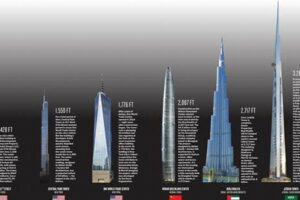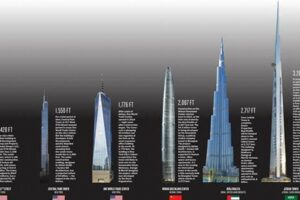The tallest skyscraper in the Western Hemisphere is a title that has been held by several buildings over the years. The current titleholder is Central Park Tower in New York City, which stands at 1,550 feet tall. Other notable skyscrapers in the Western Hemisphere include the Willis Tower in Chicago, the Empire State Building in New York City, and the First Canadian Place in Toronto.
Skyscrapers are important for a number of reasons. They can provide much-needed office space in densely populated urban areas, and they can also be used to create iconic landmarks. In addition, skyscrapers can be a source of civic pride and can help to attract tourism. For example, the Empire State Building is one of the most recognizable buildings in the world and is a popular tourist destination.
The history of skyscrapers dates back to the late 19th century, when the invention of the elevator made it possible to build tall buildings. The first skyscraper was the Home Insurance Building in Chicago, which was completed in 1885 and stood at 10 stories tall. Since then, skyscrapers have become increasingly tall and sophisticated, and they continue to be an important part of the urban landscape.
1. Height
The height of the tallest skyscraper in the Western Hemisphere is a key defining characteristic. To earn the title of “tallest,” a skyscraper must soar well above its peers, reaching an altitude of at least 1,000 feet. This extraordinary height is not merely a matter of aesthetics; it presents significant engineering challenges and requires innovative design solutions.
- Structural Integrity: Constructing a building of such immense height demands exceptional structural integrity. Engineers must carefully calculate the distribution of weight and forces acting on the structure to ensure stability and resilience against strong winds and seismic activity.
- Elevator Systems: Transporting people and goods efficiently to the upper floors of a skyscraper over 1,000 feet tall requires advanced elevator systems. High-speed elevators with multiple cabins operate in tandem to minimize wait times and provide seamless vertical transportation.
- Fire Safety: Ensuring the safety of occupants in the event of a fire is paramount in skyscrapers. Comprehensive fire safety systems, including sprinklers, smoke detectors, and evacuation plans, are meticulously designed and implemented to safeguard lives.
- Sustainability: Modern skyscrapers prioritize sustainability, incorporating eco-friendly features to reduce their environmental impact. This includes energy-efficient lighting, water conservation systems, and the use of recycled materials in construction.
The height of the tallest skyscraper in the Western Hemisphere is not just a number; it represents the culmination of human ingenuity, engineering prowess, and architectural vision. Each skyscraper that claims this title pushes the boundaries of what is possible, reshaping skylines and becoming iconic landmarks that symbolize progress and ambition.
2. Location
The location of the tallest skyscraper in the Western Hemisphere is not coincidental. Major cities offer a unique combination of factors that make them ideal for the construction of these architectural marvels:
- Economic Hubs: Major cities are economic powerhouses, attracting businesses, financial institutions, and corporations from around the world. These entities require substantial office space, driving the demand for high-rise buildings.
- Land Availability: While land in major cities is often scarce, it is also highly valuable. Constructing a skyscraper allows developers to maximize their investment by building upwards, creating more rentable space on a limited footprint.
- Infrastructure: Major cities possess well-developed infrastructure, including transportation networks, utilities, and telecommunications systems. These are essential for supporting the construction and operation of skyscrapers.
- Cultural Significance: Skyscrapers have become iconic symbols of urban progress and economic vitality. Major cities compete to build the tallest and most impressive skyscrapers, which serve as landmarks and tourist attractions.
The connection between location and the title of “tallest skyscraper in the Western Hemisphere” is evident in the history of these structures. New York City has held the title multiple times, with buildings such as the Empire State Building and One World Trade Center. Chicago has also been home to the tallest skyscraper, with the Willis Tower (formerly Sears Tower). In recent years, Toronto has emerged as a contender, with the First Canadian Place and CN Tower dominating the skyline.
Understanding the importance of location in the context of the “tallest skyscraper in the Western Hemisphere” provides insights into the factors that drive the construction of these architectural wonders. It highlights the interplay between economic, practical, and symbolic considerations in shaping the urban landscape.
3. Design
The design of the tallest skyscraper in the Western Hemisphere is not merely about aesthetics; it is a statement of architectural prowess and a symbol of the city’s identity. Iconic skyscrapers are instantly recognizable, becoming landmarks that define the skyline and attract visitors from around the world.
- Architectural Innovation: The tallest skyscrapers push the boundaries of architectural design, showcasing innovative structural systems, cladding materials, and building techniques. These skyscrapers become testaments to the creativity and ingenuity of architects and engineers.
- Cultural Expression: The design of the tallest skyscraper often reflects the cultural and architectural heritage of the city in which it is located. By incorporating local motifs, materials, or design elements, these skyscrapers become symbols of civic pride and cultural identity.
- Functional Considerations: While aesthetics are important, the design of the tallest skyscraper must also consider functional aspects such as energy efficiency, wind resistance, and occupant comfort. Sustainable design features and cutting-edge technologies are integrated to create high-performance buildings.
- Symbolic Meaning: Skyscrapers have long been associated with power, prestige, and economic prosperity. The tallest skyscraper in the Western Hemisphere becomes a symbol of the city’s ambition and its place in the global economic landscape.
The design of the tallest skyscraper in the Western Hemisphere is a complex interplay of architectural vision, engineering ingenuity, cultural expression, and functional considerations. These skyscrapers are not just buildings; they are iconic landmarks that shape the identity of our cities and symbolize the aspirations of the people who live in them.
4. Construction
The construction of the tallest skyscraper in the Western Hemisphere is a monumental undertaking that involves meticulous planning, cutting-edge engineering, and years of dedicated work. This multifaceted process demands the highest levels of expertise and collaboration among architects, engineers, contractors, and various stakeholders.
- Architectural Vision: The construction of the tallest skyscraper in the Western Hemisphere begins with a bold architectural vision that pushes the boundaries of design and engineering. Architects envision a structure that not only meets functional requirements but also becomes an iconic landmark, symbolizing the city’s aspirations and identity.
- Engineering Innovation: The engineering of the tallest skyscraper in the Western Hemisphere is a masterpiece of structural ingenuity. Engineers must design a building that can withstand immense gravitational forces, high winds, and seismic activity. They employ innovative structural systems, advanced materials, and sophisticated wind-engineering techniques to ensure the stability and safety of the skyscraper.
- Construction Expertise: The construction of the tallest skyscraper in the Western Hemisphere requires the expertise of highly skilled contractors and workers. They utilize specialized equipment, advanced construction methods, and stringent quality control measures to ensure that the building meets the highest standards of safety, durability, and efficiency.
- Project Management: The construction of the tallest skyscraper in the Western Hemisphere is a complex project that requires meticulous planning and coordination. Project managers oversee every aspect of the construction process, from design development to completion. They manage timelines, budgets, resources, and stakeholder communications to ensure that the project is delivered on time, within budget, and to the highest quality standards.
The construction of the tallest skyscraper in the Western Hemisphere is a testament to human ambition, engineering prowess, and architectural vision. It represents the culmination of years of planning, innovation, and collaboration, resulting in a structure that reshapes the skyline and becomes a symbol of progress and achievement.
5. Cost
The cost of constructing the tallest skyscraper in the Western Hemisphere is a significant factor that shapes its design, engineering, and overall feasibility. The immense height and complexity of these structures require substantial investments in materials, labor, and technology.
The cost of constructing the tallest skyscraper in the Western Hemisphere is directly related to its height. As buildings reach greater heights, the engineering challenges increase exponentially. Structural systems must be reinforced to withstand wind loads and seismic activity, and specialized materials are often required to achieve the desired strength-to-weight ratio.
Another major cost driver is the use of advanced construction techniques and technologies. The construction of supertall skyscrapers requires specialized equipment, such as high-capacity cranes and self-climbing formwork systems. Additionally, innovative construction methods, such as modular construction and prefabrication, can help to reduce costs while maintaining high quality standards.
The cost of the tallest skyscraper in the Western Hemisphere also includes the cost of land acquisition, which can be particularly high in major urban centers. Developers must carefully evaluate the financial viability of a project based on the potential return on investment.
Understanding the cost of constructing the tallest skyscraper in the Western Hemisphere is crucial for assessing the economic feasibility of such projects. Developers and investors must carefully weigh the costs against the potential benefits, including rental income, tourism revenue, and the prestige associated with owning the tallest building in the hemisphere.
6. Tenant
The presence of a diverse tenant mix is a defining characteristic of the tallest skyscrapers in the Western Hemisphere. These buildings are not merely vertical landmarks; they are thriving mixed-use developments that cater to a wide range of occupants and activities.
The inclusion of office space is a key component of the tallest skyscrapers’ success. These buildings offer prime office space with stunning views, attracting prestigious businesses and financial institutions. The concentration of corporate headquarters and professional services in these skyscrapers creates a vibrant business environment and contributes to the economic vitality of the surrounding area.
Residential units, including luxury apartments and condominiums, are another common feature of the tallest skyscrapers. These units offer residents unparalleled views and access to exclusive amenities, making them highly desirable and sought-after. The presence of residential units also creates a sense of community within the skyscraper, fostering a sense of belonging and pride among its occupants.
Retail stores and commercial spaces are often integrated into the lower levels of the tallest skyscrapers. These spaces provide convenience and accessibility for tenants and visitors alike. The presence of retail stores also contributes to the vibrancy of the surrounding neighborhood, creating a lively and dynamic atmosphere.
Understanding the connection between the tenant mix and the success of the tallest skyscrapers in the Western Hemisphere is crucial for developers, architects, and urban planners. By carefully considering the needs of potential tenants and creating a diverse and balanced tenant mix, these buildings can maximize their value, attract a wide range of occupants, and contribute to the overall vitality of the urban environment.
7. View
The breathtaking views offered by the tallest skyscrapers in the Western Hemisphere are a major draw for tourists from around the world. These buildings provide unparalleled vantage points, allowing visitors to experience the city from a whole new perspective.
- Panoramic Views: The height of the tallest skyscrapers offers unobstructed panoramic views of the surrounding cityscape. Visitors can take in the entire skyline, from iconic landmarks to hidden gems, all from the comfort of a single observation deck.
- Architectural Details: From intricate facades to soaring spires, the architectural details of the tallest skyscrapers are best appreciated from a bird’s-eye view. Visitors can admire the craftsmanship and design that went into creating these architectural marvels.
- Geographic Orientation: The tallest skyscrapers provide a unique opportunity to gain a geographic orientation of the city. Visitors can easily identify major landmarks, rivers, and other geographic features, helping them to navigate and explore the city below.
- Sunset and Night Views: As the sun sets, the tallest skyscrapers transform into beacons of light, offering stunning views of the city’s skyline illuminated against the night sky. These views are particularly popular with tourists looking for romantic or memorable experiences.
The connection between the views offered by the tallest skyscrapers and their status as popular tourist destinations is undeniable. These buildings have become iconic landmarks in their own right, attracting visitors who are eager to experience the unparalleled views they offer. The combination of stunning vistas, architectural marvels, and geographic orientation makes the tallest skyscrapers in the Western Hemisphere must-visit attractions for tourists from all over the world.
8. Landmark
The status of the tallest skyscraper in the Western Hemisphere as an iconic landmark is closely tied to its inherent characteristics and the broader context in which it exists. Several factors contribute to this connection:
Height and Architectural Significance: The extraordinary height and architectural grandeur of the tallest skyscraper make it a visually striking and recognizable structure. Its towering presence dominates the skyline, becoming a focal point and a symbol of the city’s ambition and economic power. The architectural design, often incorporating innovative and awe-inspiring features, further enhances its iconic status.
Economic Symbolism: The tallest skyscraper is often seen as a representation of the city’s economic vitality and prosperity. Its construction requires substantial investment and resources, indicating a thriving economy and a favorable business climate. The building’s tenants, typically consisting of prestigious corporations and financial institutions, contribute to this image of economic success.
Cultural Significance: The tallest skyscraper can hold cultural significance for the city and its residents. It becomes a source of pride and a symbol of the city’s aspirations and achievements. The building’s design may incorporate elements of local culture or history, further strengthening its connection to the community.
Tourist Attraction: The iconic status of the tallest skyscraper makes it a popular tourist destination. Visitors from around the world are drawn to experience the breathtaking views from observation decks, admire the architectural marvel, and capture memorable photographs. This influx of tourism contributes to the city’s economy and reinforces the building’s status as a landmark.
Understanding the connection between the tallest skyscraper in the Western Hemisphere and its role as an iconic landmark is essential for appreciating the significance of these structures. They are not merely tall buildings but symbols of economic prosperity, architectural prowess, and cultural identity. Preserving and celebrating these landmarks is crucial for maintaining the vitality and heritage of our cities.
9. Pride
The connection between the title of “tallest skyscraper in the Western Hemisphere” and the sense of pride it evokes is deeply rooted in human nature and societal values. Skyscrapers, by virtue of their sheer height and architectural grandeur, have always captured the imagination and admiration of people around the world. They represent ambition, innovation, and the ability to push the boundaries of engineering and design.
When a city or country is home to the tallest skyscraper in the Western Hemisphere, it is a tangible symbol of progress and prosperity. It signifies that the city has the economic to undertake such a monumental project and that it is a hub of architectural innovation. The presence of a record-breaking skyscraper can boost the city’s reputation and attract global attention, leading to increased tourism, investment, and economic growth.
For example, the construction of the Empire State Building in New York City during the Great Depression was a source of immense pride for both the city and the nation. It represented a beacon of hope and resilience during a challenging time and became an iconic symbol of American ingenuity. Similarly, the Burj Khalifa in Dubai, currently the tallest building in the world, has become a symbol of the United Arab Emirates’ rapid economic development and its global ambitions.
Understanding the connection between the tallest skyscraper in the Western Hemisphere and the sense of pride it evokes is important for several reasons. First, it highlights the importance of architecture and engineering in shaping our cities and instilling a sense of civic pride. Second, it demonstrates the role of iconic landmarks in promoting tourism and economic development. Third, it reminds us of the human capacity for innovation and the pursuit of excellence.
FAQs about the Tallest Skyscraper in the Western Hemisphere
The title of “tallest skyscraper in the Western Hemisphere” is a prestigious one, and the building that holds this title is often the subject of public curiosity and fascination. Here are answers to some frequently asked questions about the tallest skyscraper in the Western Hemisphere:
Question 1: What is the current tallest skyscraper in the Western Hemisphere?
Answer: As of 2023, the tallest skyscraper in the Western Hemisphere is Central Park Tower in New York City, standing at 1,550 feet tall with 119 stories.
Question 2: What are some of the unique features of the tallest skyscraper in the Western Hemisphere?
Answer: The tallest skyscraper in the Western Hemisphere often incorporates innovative architectural designs, sustainable building practices, and cutting-edge technologies. These features can include sky gardens, observation decks, high-speed elevators, and energy-efficient systems.
Question 3: What is the significance of the tallest skyscraper in the Western Hemisphere?
Answer: The tallest skyscraper in the Western Hemisphere is a symbol of architectural prowess, economic vitality, and civic pride. It represents the ability to push the boundaries of design and engineering, and serves as a landmark that attracts tourists and businesses alike.
Question 4: How does the tallest skyscraper in the Western Hemisphere compare to other skyscrapers around the world?
Answer: The tallest skyscraper in the Western Hemisphere is typically among the tallest buildings in the world, but its ranking may vary depending on the completion of new skyscrapers in other regions. For instance, the Burj Khalifa in Dubai currently holds the title of the tallest building in the world.
Question 5: What are the future prospects for the tallest skyscraper in the Western Hemisphere?
Answer: The future of the tallest skyscraper in the Western Hemisphere is constantly evolving, with new proposals and construction projects emerging regularly. Architectural advancements and technological innovations may lead to even taller and more sustainable skyscrapers in the future.
Question 6: What are some of the challenges involved in constructing and maintaining the tallest skyscraper in the Western Hemisphere?
Answer: Constructing and maintaining the tallest skyscraper in the Western Hemisphere presents significant engineering, financial, and logistical challenges. These challenges include ensuring structural stability, implementing fire safety measures, managing wind loads, and providing efficient energy and transportation systems.
By understanding these frequently asked questions, you can gain a deeper appreciation for the architectural marvels that are the tallest skyscrapers in the Western Hemisphere.
As the quest for building taller and more innovative skyscrapers continues, the title of “tallest skyscraper in the Western Hemisphere” will likely change hands in the future. However, the fascination and admiration for these architectural wonders will undoubtedly endure.
Continue reading to explore more about the tallest skyscraper in the Western Hemisphere, including its history, design, and impact on the surrounding environment and community.
Tips for Understanding the Tallest Skyscraper in the Western Hemisphere
The tallest skyscraper in the Western Hemisphere is a marvel of engineering and architecture, but its significance extends beyond its height and grandeur. Here are a few tips to help you fully appreciate and understand these architectural wonders:
Tip 1: Consider Historical Context: Understanding the historical context in which a skyscraper was built can provide valuable insights into its design and purpose. Research the economic, social, and technological factors that influenced its construction.
Tip 2: Explore Architectural Details: Pay attention to the architectural details of the skyscraper, both inside and out. Examine the facade, structural elements, and interior spaces to appreciate the creativity and innovation of the architects and engineers.
Tip 3: Learn About Engineering Innovations: The tallest skyscrapers often showcase cutting-edge engineering solutions. Investigate the structural systems, wind-resistance measures, and sustainability features that enable these buildings to withstand various environmental forces.
Tip 4: Understand the Impact on the City: Consider the impact of the tallest skyscraper on the surrounding cityscape and community. Analyze how its height, design, and location influence urban planning, transportation, and the overall character of the city.
Tip 5: Visit Observation Decks: If possible, visit the observation decks of the tallest skyscrapers to experience firsthand the breathtaking views they offer. This perspective provides a unique understanding of the city’s layout and the scale of the building.
Tip 6: Read and Research: Explore books, articles, and documentaries about the tallest skyscrapers to gain a deeper understanding of their construction, design, and cultural significance.
Tip 7: Appreciate the Symbolism: Recognize the symbolic value of the tallest skyscraper as a representation of a city’s economic power, technological prowess, and architectural ambition.
Tip 8: Consider Sustainability: Examine the sustainability features incorporated into the tallest skyscrapers, such as energy-efficient systems, water conservation measures, and green building practices. Understand how these buildings contribute to environmental protection.
By following these tips, you can develop a comprehensive understanding and appreciation for the tallest skyscraper in the Western Hemisphere, transcending its physical presence to grasp its historical, architectural, and cultural significance.
Remember, the tallest skyscraper is not merely a building but a testament to human ingenuity, architectural brilliance, and the ever-evolving relationship between cities and their built environment.
Conclusion
The title of “tallest skyscraper in the Western Hemisphere” is bestowed upon a select few architectural marvels that represent the pinnacle of human ingenuity and engineering prowess. These colossal structures have reshaped skylines, symbolized economic power, and pushed the boundaries of architectural design.
Throughout this exploration, we have delved into the various aspects that define the tallest skyscraper in the Western Hemisphere. We have examined its historical significance, architectural innovations, engineering challenges, and cultural impact. By understanding these factors, we gain a deeper appreciation for the complexity and grandeur of these architectural wonders.
As we look towards the future, the race to build taller and more sustainable skyscrapers continues. New technologies and design concepts are emerging, promising to redefine the limits of architectural possibility. The tallest skyscraper in the Western Hemisphere will undoubtedly continue to evolve, reflecting the ever-changing landscape of our cities and our relentless pursuit of architectural excellence.







